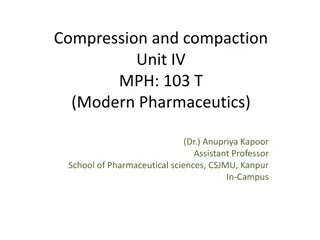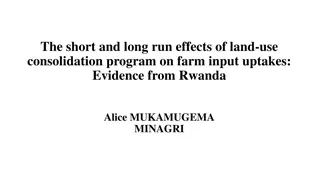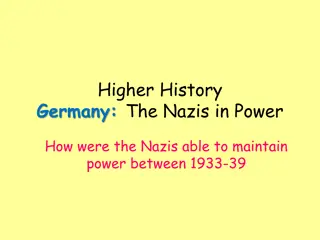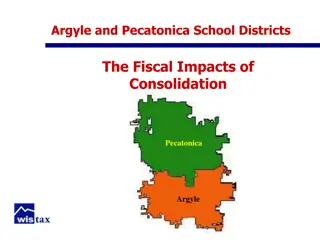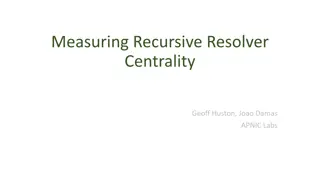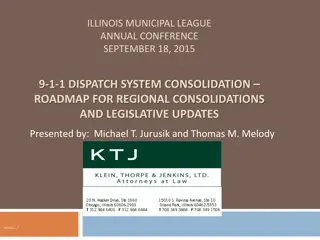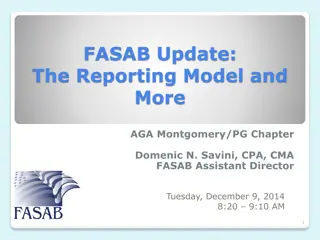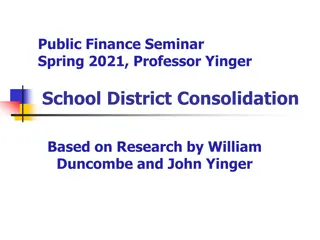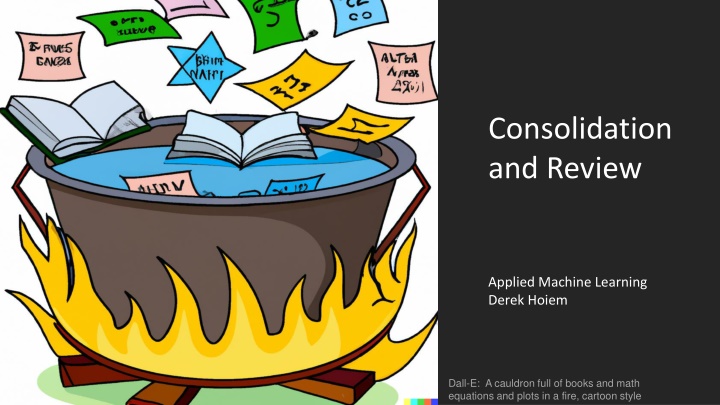
Applied Machine Learning: Training, Prediction, and Model Evaluation
Dive into the world of applied machine learning with a focus on training models, making predictions, and evaluating model performance. Explore concepts like parameter learning, feature selection, regression, classification, and model optimization. Understand the key steps in the model evaluation process and how to think about machine learning algorithms effectively.
Download Presentation

Please find below an Image/Link to download the presentation.
The content on the website is provided AS IS for your information and personal use only. It may not be sold, licensed, or shared on other websites without obtaining consent from the author. If you encounter any issues during the download, it is possible that the publisher has removed the file from their server.
You are allowed to download the files provided on this website for personal or commercial use, subject to the condition that they are used lawfully. All files are the property of their respective owners.
The content on the website is provided AS IS for your information and personal use only. It may not be sold, licensed, or shared on other websites without obtaining consent from the author.
E N D
Presentation Transcript
Consolidation and Review Applied Machine Learning Derek Hoiem Dall-E: A cauldron full of books and math equations and plots in a fire, cartoon style
Training (Parameter Learning) Target Labels Model Raw Features Encoder Decoder Prediction Category Continuous value Discrete/continuous values Images Trees Feature selection Linear regressor Logistic regressor Nearest Neighbor Probabilistic model Clusters Low dimensional embedding Pixel labels Generated text, image, audio Positions Text Images Audio Structured/unstructured Few/many features Clean/noisy labels Manual feature design Deep networks Clustering Kernels Density estimation SVM
Learning a model ? = argmin ????(? ?;? ,?) ? ? ?;? : the model, e.g. ? = ??? ?: parameters of the model (?,?): pairs of training samples ????(): defines what makes a good model Good predictions, e.g. minimize ?log?(??|??) Likely parameters, e.g. minimize ??? Regularization and priors indicate preference for particular solutions, which tends to improve generalization (for well chosen parameters) and can be necessary to obtain a unique solution
Prediction using a model ??= ? ??;? Given some new set of input features ??, model predicts ?? Regression: output ?? directly, possibly with some variance Classification Output most likely ?? directly, as in nearest neighbor or Na ve Bayes Output ?(??|??), as in logistic regression
Model evaluation process 1. Collect/define training, validation, and test sets 2. Decide on some candidate models and parameters 3. For each candidate: a. Learn parameters with training set b. Evaluate trained model on the validation set 4. Select best model 5. Evaluate best model s performance on the test set Cross-validation can be used as an alternative Common measures include error or accuracy, root mean squared error, precision-recall
How to think about ML algorithms What is the model? What kinds of functions can it represent? What functions does it prefer? (regularization/prior) What is the objective function? What values are implied? Note that the objective function often does not match the final evaluation metric Objectives are designed to be optimizable and improve generalization How do I optimize the model? How long does it take to train, and how does it depend on the amount of training data or number of features? Can I reach a global optimum? How does the prediction work? How fast can I make a prediction for a new sample? Can I find the most likely prediction according to my model? Does my algorithm provide a confidence on its prediction?
Classification methods Nearest Neighbor Na ve Bayes Logistic Regression Decision Tree Instance-Based Probabilistic Probabilistic Probabilistic Type Partition by example distance Usually linear Usually linear Partition by selected boundaries Decision Boundary ? = argmin ???? ????[?],? ? = ????? Conjunctive rules ? = ????(?) Model / Prediction ? = argmax ? ??? ?(?) ? ? ? ? = argmax ? ? ? ? * Low bias * No training time * Widely applicable * Simple * Estimate from limited data * Simple * Fast training/prediction * Powerful in high dimensions * Widely applicable * Good confidence estimates * Fast prediction * Explainable decision function * Widely applicable * Does not require feature scaling Strengths * Relies on good input features * Slow prediction (in basic implementation) * Limited modeling power * Relies on good input features * One tree tends to either generalize poorly or underfit the data Limitations
Classification methods (extended) assuming x in {0 1} Learning Objective Training Inference ( ) P T T + ( ) x x 1 0 x ( ) 1 0 ( ( ) ) 1 = = + 1 x y k r log | ; P x y | 1 = = 1 y Na ve Bayes ij i ij i j j = where log , maximize = 1 j = = i | 1 = 0 P x y j ( ) Kr + j ( ) kj ( ( ) = y k + log ; = P y | 0 P x y i i j = log ) 0 0 i 0 j = = i | 0 P x y j Logistic Regression m??????? log ? ??|?,? + ? ? T x t Gradient descent ? where ? ??|?,? = 1/ 1 + exp ????? 1 i y + minimize Quadratic programming or subgradient opt. Linear SVM i 2 T x t T x such that 1 , 0 i i i i ( ) Kernelized SVM i Quadratic programming x x , 0 y K complicated to write i i i y Nearest Neighbor i ( ) most similar features same label Record data = x , x where argmin i K i i * Notation may differ from previous slide
Regression methods Nearest Neighbor Na ve Bayes Linear Regression Decision Tree Instance-Based Probabilistic Data fit Probabilistic Type Partition by example distance Usually linear Linear Partition by selected boundaries Decision Boundary ? = ??? ? = argmin ???? ????[?],? ? = ????? Conjunctive rules ? = ????(?) Model / Prediction ? = argmax ? ??? ?(?) ? ? ? * Low bias * No training time * Widely applicable * Simple * Estimate from limited data * Simple * Fast training/prediction * Powerful in high dimensions * Widely applicable * Fast prediction * Coefficients may be interpretable * Explainable decision function * Widely applicable * Does not require feature scaling Strengths * Relies on good input features * Slow prediction (in basic implementation) * Limited modeling power * Relies on good input features * One tree tends to either generalize poorly or underfit the data Limitations
Performance vs training size As we get more training data: 1. The same model has more difficulty fitting the data 2. But the test error becomes closer to training error (reduced generalization error) 3. Overall test performance improves Fixed model Due to limited training data (model variance) and distribution shift Testing Error Test error with infinite training examples Due to difference in P(y|x) in training and test (function shift) Train error with infinite training examples Training Number of Training Examples Due to limited power of model (model bias) and unavoidable intrinsic error (Bayes optimal error)
Example: Breast Cancer Classification Motivation Breast cancer diagnosis from fine needle aspirates (FNA) is reported to be 94%, but results are suspected to be biased Need computer-based tests that are less subjective so that FNA is a more effective diagnostic tool for breast cancer Collected data from 569 patients, plus 54 for held-out testing A user interface was created to outline borders of suspect cells, and automated measurement of ten characteristics (e.g. radius, area, compactness, ) was performed and mean of all cells, mean of 3 largest, and std were recorded for each patient [paper (Wolberg et al. 1995)]
Lets explore in Python https://colab.research.google.com/drive/1viVU62gk77THZBFuzt WjxgL93xMMpiU0?usp=sharing
Method/Results from Breast Cancer Analysis Paper A MSM-Tree was used for classification Fits a linear classifier based on a few features for each split Aimed to minimize the number of splitting planes and number of features used (for simplicity and to improve generalization) Final approach was splitting plane based on mean texture, worst area, and worst smoothness 10-fold cross validatdion Achieved 3% error (+- 1.5% for 95% confidence interval) Perfect accuracy in held out test set
Next week Ensembles: model averaging and forests SVM and stochastic gradient descent




